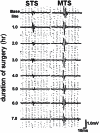Basic Principles and Recent Trends of Transcranial Motor Evoked Potentials in Intraoperative Neurophysiologic Monitoring
- PMID: 26935781
- PMCID: PMC4987444
- DOI: 10.2176/nmc.ra.2015-0307
Basic Principles and Recent Trends of Transcranial Motor Evoked Potentials in Intraoperative Neurophysiologic Monitoring
Abstract
Transcranial motor evoked potentials (TcMEPs), which are muscle action potentials elicited by transcranial brain stimulation, have been the most popular method for the last decade to monitor the functional integrity of the motor system during surgery. It was originally difficult to record reliable and reproducible potentials under general anesthesia, especially when inhalation-based anesthetic agents that suppressed the firing of anterior horn neurons were used. Advances in anesthesia, including the introduction of intravenous anesthetic agents, and progress in stimulation techniques, including the use of pulse trains, improved the reliability and reproducibility of TcMEP responses. However, TcMEPs are much smaller in amplitude compared with compound muscle action potentials evoked by maximal peripheral nerve stimulation, and vary from one trial to another in clinical practice, suggesting that only a limited number of spinal motor neurons innervating the target muscle are excited in anesthetized patients. Therefore, reliable interpretation of the critical changes in TcMEPs remains difficult and controversial. Additionally, false negative cases have been occasionally encountered. Recently, several facilitative techniques using central or peripheral stimuli, preceding transcranial electrical stimulation, have been employed to achieve sufficient depolarization of motor neurons and augment TcMEP responses. These techniques might have potentials to improve the reliability of intraoperative motor pathway monitoring using TcMEPs.
Conflict of interest statement
The authors declare that there is no conflict of interest regarding this article.
Figures



Similar articles
-
Augmentation of motor evoked potentials using multi-train transcranial electrical stimulation in intraoperative neurophysiologic monitoring during spinal surgery.J Clin Monit Comput. 2015 Feb;29(1):35-9. doi: 10.1007/s10877-014-9565-7. Epub 2014 Feb 16. J Clin Monit Comput. 2015. PMID: 24532184
-
Crossover Phenomena in Motor Evoked Potentials During Intraoperative Neurophysiological Monitoring of Cranial Surgeries.J Clin Neurophysiol. 2019 May;36(3):236-241. doi: 10.1097/WNP.0000000000000570. J Clin Neurophysiol. 2019. PMID: 30893247
-
Quantification of the proportion of motor neurons recruited by transcranial electrical stimulation during intraoperative motor evoked potential monitoring.J Clin Monit Comput. 2013 Dec;27(6):633-7. doi: 10.1007/s10877-013-9480-3. Epub 2013 Jun 8. J Clin Monit Comput. 2013. PMID: 23748599
-
Intraoperative Neurophysiologic Monitoring for Degenerative Cervical Myelopathy.Neurosurg Clin N Am. 2018 Jan;29(1):159-167. doi: 10.1016/j.nec.2017.09.012. Epub 2017 Oct 27. Neurosurg Clin N Am. 2018. PMID: 29173429 Review.
-
Impact of anesthesia on transcranial electric motor evoked potential monitoring during spine surgery: a review of the literature.Neurosurg Focus. 2009 Oct;27(4):E7. doi: 10.3171/2009.8.FOCUS09145. Neurosurg Focus. 2009. PMID: 19795956 Review.
Cited by
-
Transcranial Motor Evoked Potentials as a Predictive Modality for Postoperative Deficit in Cervical Spine Decompression Surgery - A Systematic Review and Meta-Analysis.Global Spine J. 2024 Jun;14(5):1609-1628. doi: 10.1177/21925682231219224. Epub 2023 Dec 4. Global Spine J. 2024. PMID: 38047537 Free PMC article. Review.
-
Effect of a Low Concentration of Sevoflurane Combined With Propofol on Transcranial Electrical Stimulation Motor Evoked Potential: A Case Series.Cureus. 2023 Jul 8;15(7):e41562. doi: 10.7759/cureus.41562. eCollection 2023 Jul. Cureus. 2023. PMID: 37559854 Free PMC article.
-
Facial nerve electrical motor evoked potential in cerebellopontine angle tumors for its anatomical and functional preservation.Surg Neurol Int. 2024 May 31;15:182. doi: 10.25259/SNI_14_2024. eCollection 2024. Surg Neurol Int. 2024. PMID: 38840594 Free PMC article.
-
Transcranial motor evoked potentials electrically elicited by multi-train stimulation can reflect isolated nerve root injury more precisely than those by conventional multi-pulse stimulation: an experimental study in rats.J Clin Monit Comput. 2020 Feb;34(1):125-129. doi: 10.1007/s10877-019-00296-x. Epub 2019 Mar 5. J Clin Monit Comput. 2020. PMID: 30835023
-
Letter to Editor on "Do Intraoperative Neurophysiological Changes During Decompressive Surgery for Cervical Myeloradiculopathy Affect Functional Outcome? A Prospective Study" by Akbari et al.Global Spine J. 2024 Apr;14(3):1082-1083. doi: 10.1177/21925682231155159. Epub 2023 Feb 3. Global Spine J. 2024. PMID: 36734372 Free PMC article. No abstract available.
References
-
- Merton PA, Morton HB: Stimulation of the cerebral cortex in the intact human subject. Nature 285: 227, 1980. - PubMed
-
- Merton PA, Morton HB: Electrical stimulation of human motor and visual cortex through the scalp. J Physiol 305: 9P– 10P, 1980.
-
- Zentner J: Noninvasive motor evoked potential monitoring during neurosurgical operations on the spinal cord. Neurosurgery 24: 709– 712, 1989. - PubMed
-
- Calancie B, Klose KJ, Baier S, Green BA: Isoflurane-induced attenuation of motor evoked potentials caused by electrical motor cortex stimulation during surgery. J Neurosurg 74: 897– 904, 1991. - PubMed
-
- Deletis V, Sala F: Intraoperative neurophysiological monitoring of the spinal cord during spinal cord and spine surgery: a review focus on the corticospinal tracts. Clin Neurophysiol 119: 248– 264, 2008. - PubMed
Publication types
MeSH terms
LinkOut - more resources
Full Text Sources
Other Literature Sources

